Whistles hailing from the Camp Nou stands give an idea of how this one played out.
Unlike the Barcelona teams of old, this game was largely played in their defensive half as Real Madrid pilled on the pressure. Though Barcelona was able to generate a few quality chances, their opportunities were few and far between, allowing a clear lead in the La Liga table to slip away.
Despite the long list of injuries, Zinedine Zidane’s tactics were spot on in this one. Earning a point in Barcelona keeps Real Madrid level on point in La Liga and provides some great momentum after a lacklustre start.
El Clásico may have ended 0-0, but the score doesn’t do justice to the tactical battle that took place. In this tactical analysis, we’ll look at Real Madrid’s relentless attacking. Although Barcelona spent the better part of the game in their own half, they did create a few very dangerous opportunities on the counter and when building out of the back that deserves analysis.
Lineup
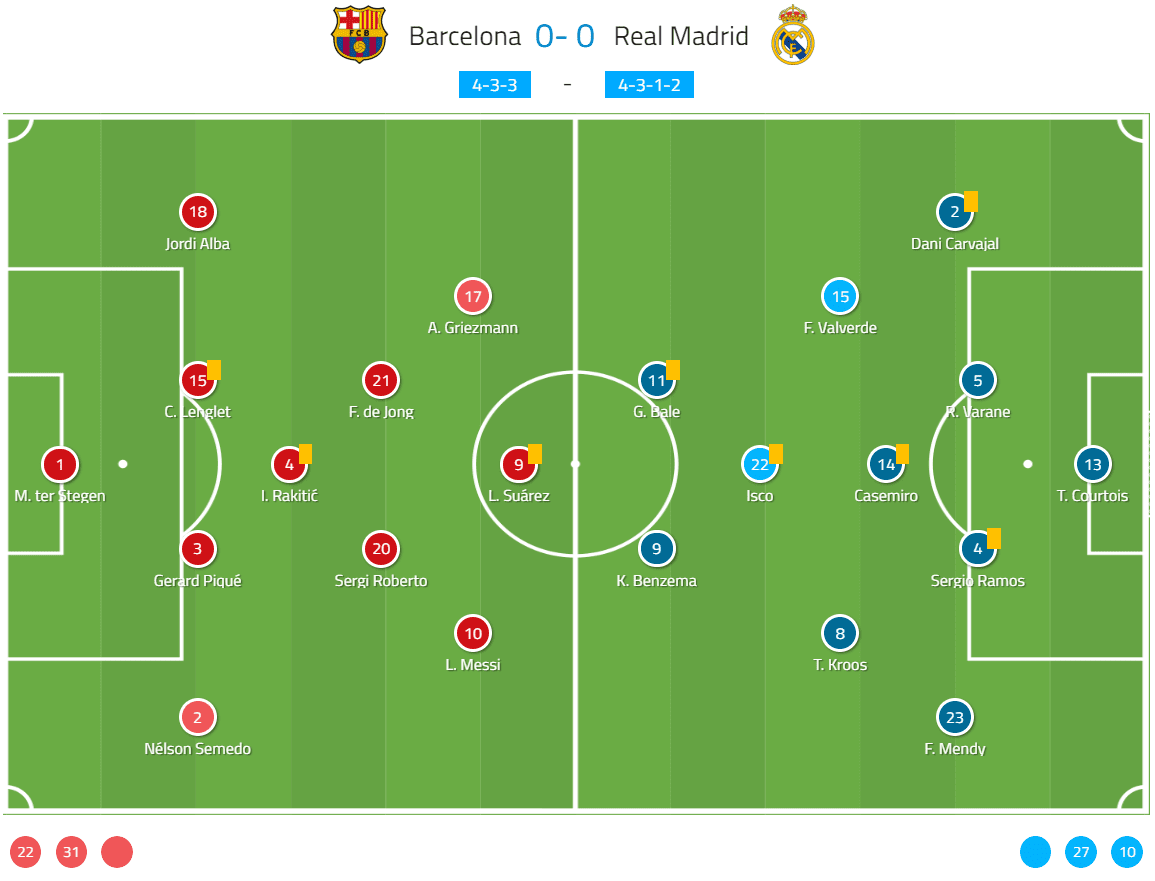
Ernesto Valverde set out his Barcelona side in their traditional 1-4-3-3. Marc-André ter Stegen took his usual place in goal. Jordi Alba, Clément Lenglet and Gerard Piqué were givens in defence, but the surprise inclusion on the back-line was Nelson Semedo. Sergio Busquets came down with a fever before the game, keeping him from the starting lineup. That moved Sergi Roberto into the midfield with Ivan Rakitic and Frankie de Jong. No surprises up top as Lionel Messi, Luis Suárez and Antoine Griezmann received the starts.
For Zidane’s starting lineup, it was a 1-4-3-1-2 that played out like a 1-4-4-2 with a diamond midfield. Thibaut Courtois started in goal with Dani Carvajal, Raphael Varane, Sergio Ramos and Ferland Mendy forming the back-line. The four-man midfield consisted of Casemiro in the holding role, young Federico Valverde at right-centre, Toni Kroos at left-centre and Isco at the top of the diamond. Karim Benzema took his usual spot up top and was paired with the recently fit Gareth Bale.
Success when building out of the back – Barcelona
While Barcelona was not able to consistently beat Madrid’s press, most of their best chances started from the back. Due to the number of turnovers and clearances from Barcelona in their defensive third, I had to take off my Pep-coloured glasses before I could see the effective, though certainly inconsistent, build-ups.
As Barcelona built up, there was very little movement up top, which is something that’s missing from the Pep and Enriquez days. Without the runs in behind the defence, the build-up consisted of safe passes between the defensive and midfield lines. That meant the build-ups were a bit on the slow side. With no runs in behind, Real Madrid managed the verticality of the lines quite easily. Barcelona was most successful in the build-up during long spells of possession. If they were able to reach the attacking third then play backward and diagonally, that movement tended to find gaps in the Real Madrid defence. In their most impressive run of play, Barcelona strung together 26 passes, leading to a Messi shot on goal and Ramos clearance.
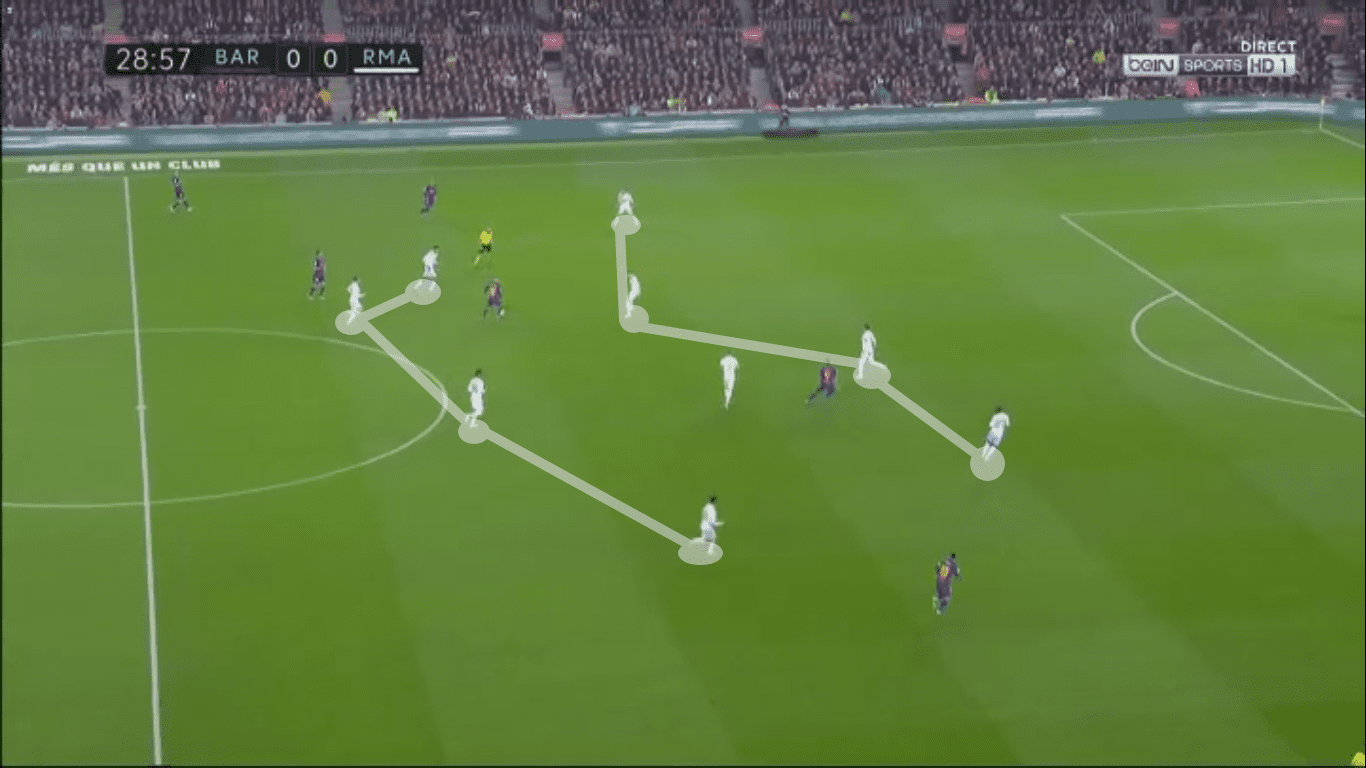
Alba received the pass, checked his options up the field and noticed his side were numbers down. Rather than forcing play into poor conditions, we opted to recycle play. This started a long string of Barcelona passes leading to a shot.
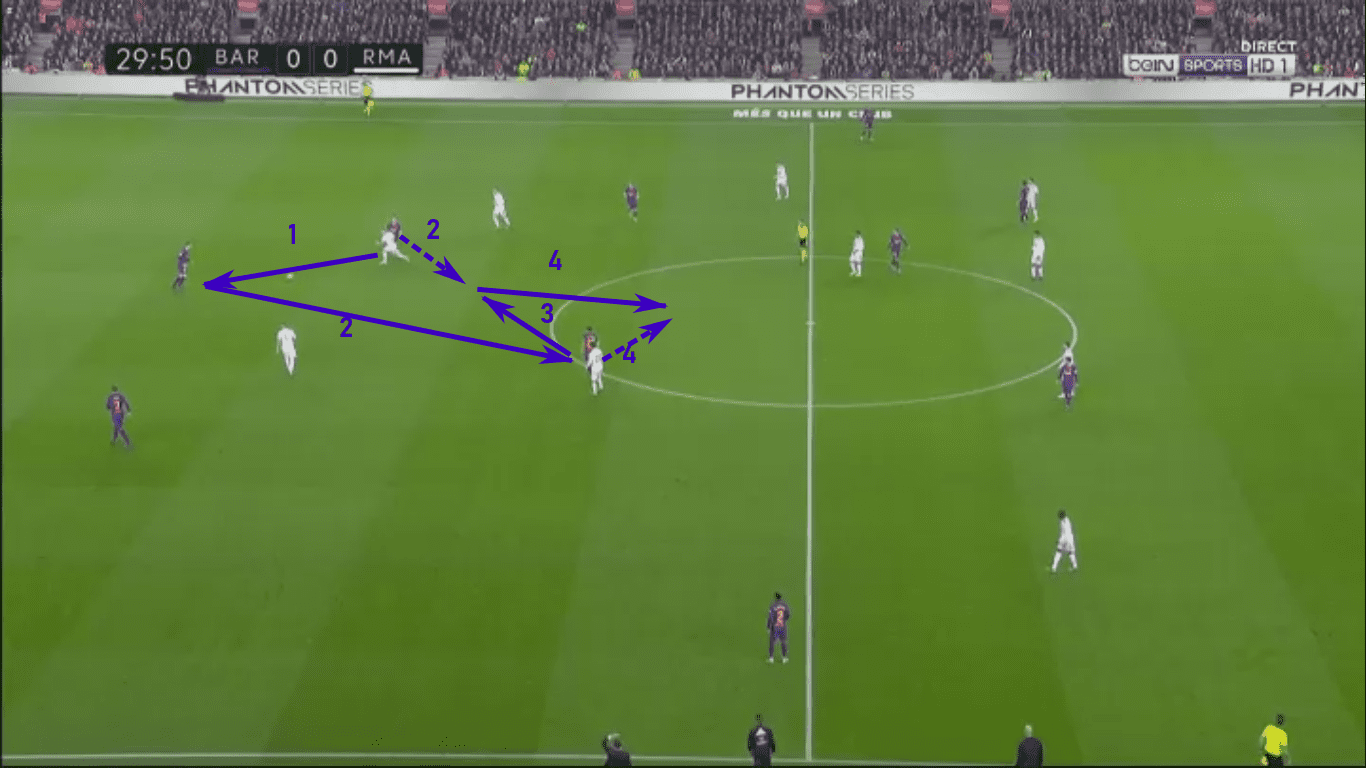
You’ll notice the attack really begins about a minute later. Pique sends a pass behind de Jong. At first glance, it looks poor. Maybe it was. However, what resulted from that pass was significant. In the previous 53 seconds, Barcelona played safe passes in the middle third, unable to move or unlock the Real Madrid defence. With the pass behind de Jong, Madrid moved up the field to press higher, but, as they do, their lines become vertically stretched. Rakitic played Lenglet, who played first time to Roberto. He sent his first touch to Rakitic, who returned for the give-and-go. The quick sequence gets them beyond Isco and Valverde, giving control of the middle to Barcelona.
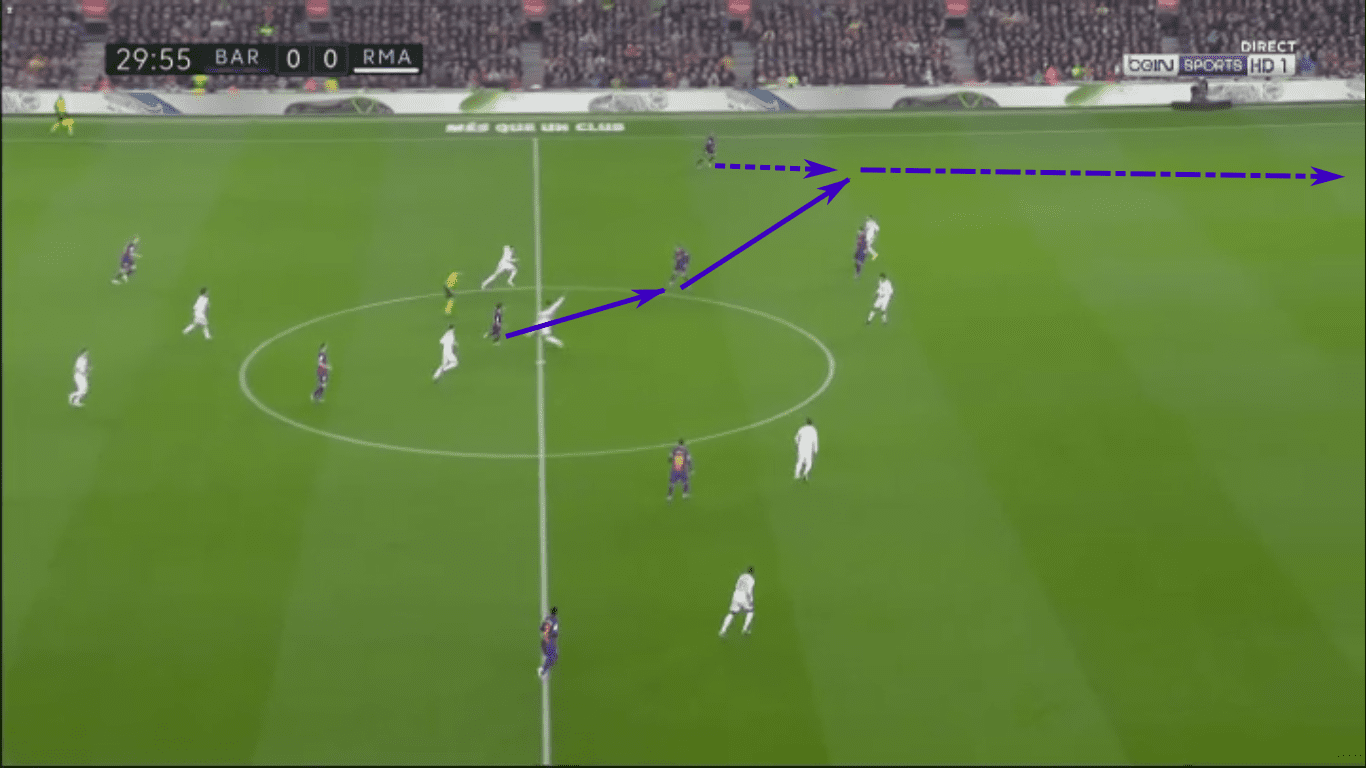
Roberto ran at the next line, taking a heavy touch to draw out Casemiro. The Brazilian lunged for the ball but missed. After Griezmann took a touch around the recovery run of Valverde, he played Alba down the wing.
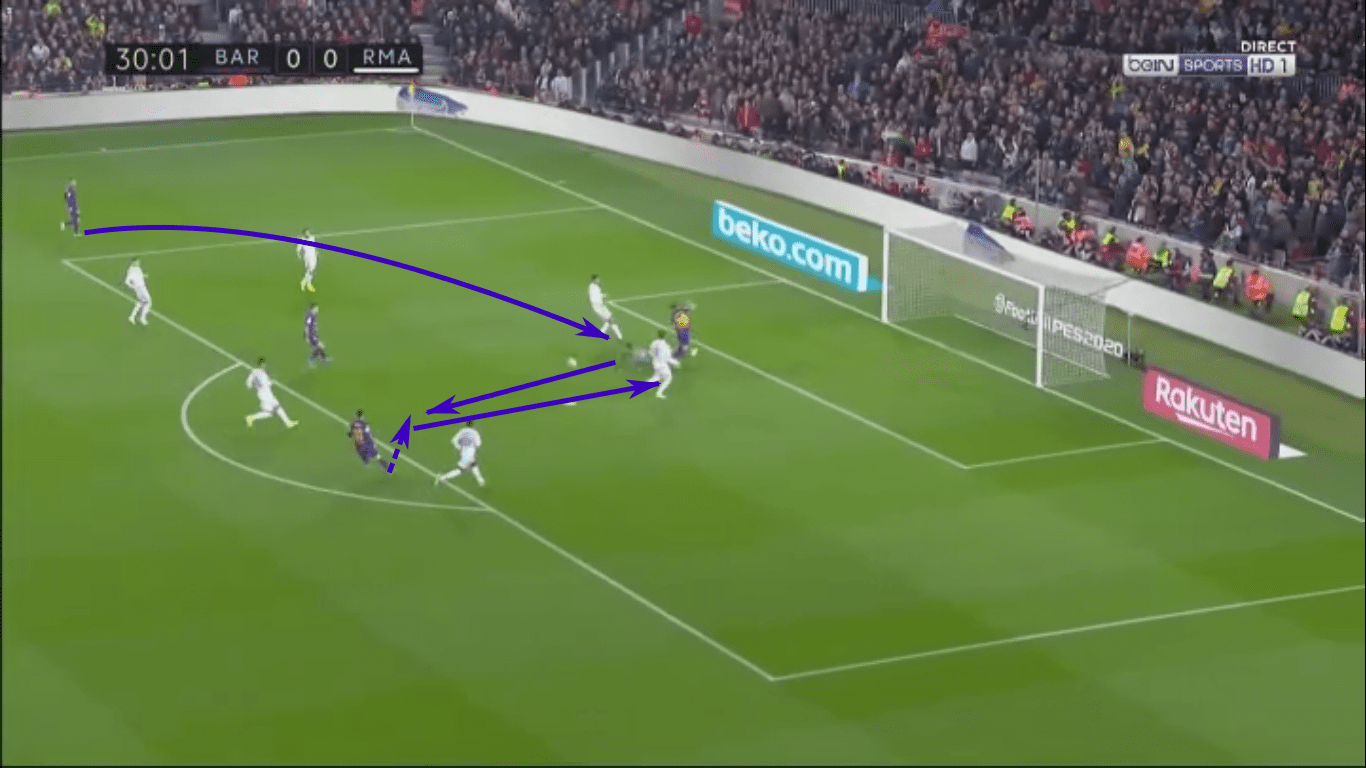
Alba ran unopposed down the wing and crossed the ball eight metres from goal. Courtois was quick to move forward and punch the ball, but a poor punch fell into Messi’s path. The Argentine took a first-time shot, only to see Ramos get the block.
Success when building out of the back – Real Madrid
Unlike Barcelona, Madrid’s build-outs tended to be much faster. Part of that is due to runs in behind the defence. Another reason is the way Zidane’s side executed the 4-4-2. With Benzema and Bale sliding into the half-spaces, they offered their teammates an overload on either side of the field. Isco added to the qualitative advantage, teaming up with one of the two pairs. If Madrid played to his side, they typically enjoyed a 3v2 with safe progression, especially since they had runners moving in behind the defence to pull a defender and create more space.
The final reason I’ll point out is the manipulation of Barcelona’s high press. With little space between the Barcelona lines and a typically narrow defence, the long diagonals were always on. In instances when Barcelona maintained proper width (as you’ll see below), Madrid was able to pull them out, typically baiting them with a seemingly poor pass or touch. With the nearest defenders overcommitting, Madrid easily played out of pressure.
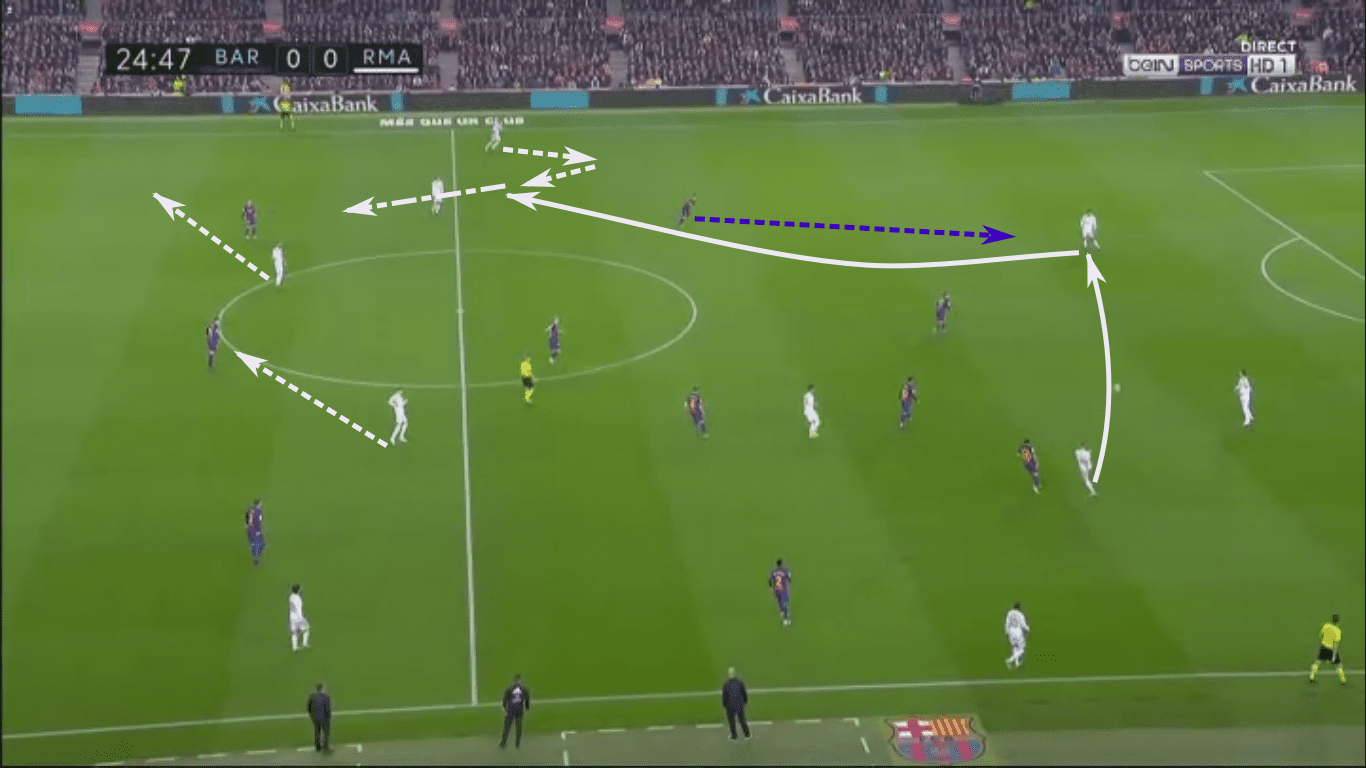
In this sequence, Madrid had already completed several passes and was waiting for Barcelona’s defence to become horizontally compact. Kroos played a soft ball to Varane, baiting Suárez to leave the right half-space to pursue the ball. Varane timed his approach perfectly, bending a beautiful first touch delivery around the onrushing defender. Carvajal claimed the ball and dribbled forward as Benzema and Valverde started their runs into space.
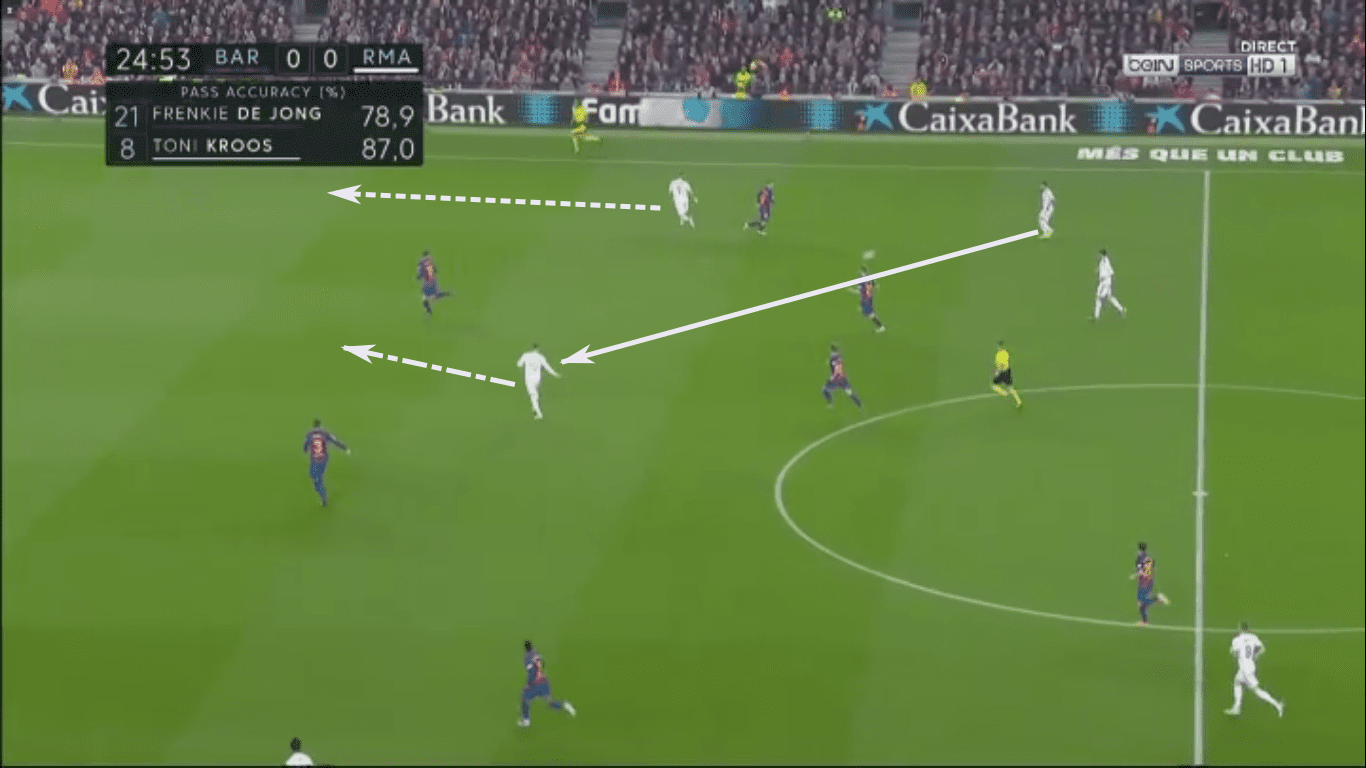
Carvajal passed to Valverde, who pinned Lenglet, allowing Benzema to start his run into the half-space.
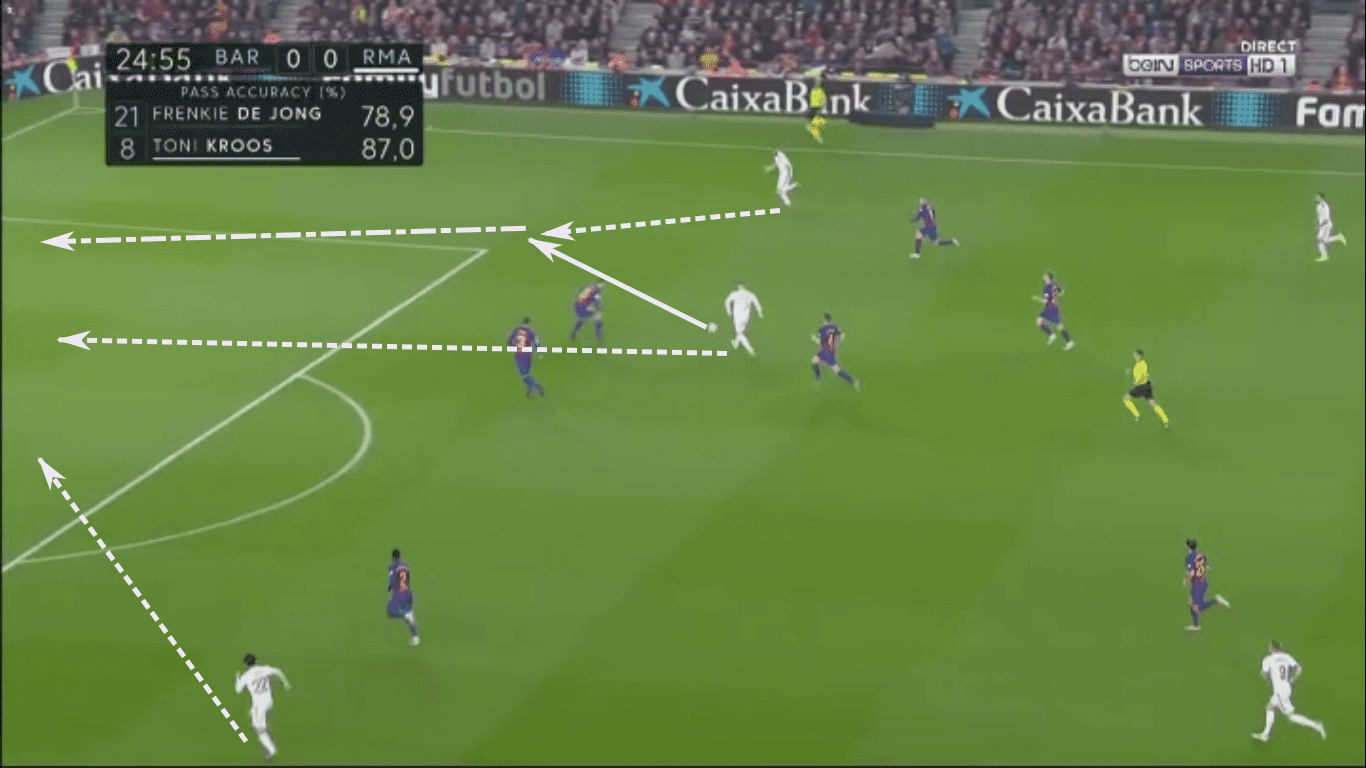
With Lenglet pinned and Benzema positioned to receive, Valverde played his teammate into the half-space.
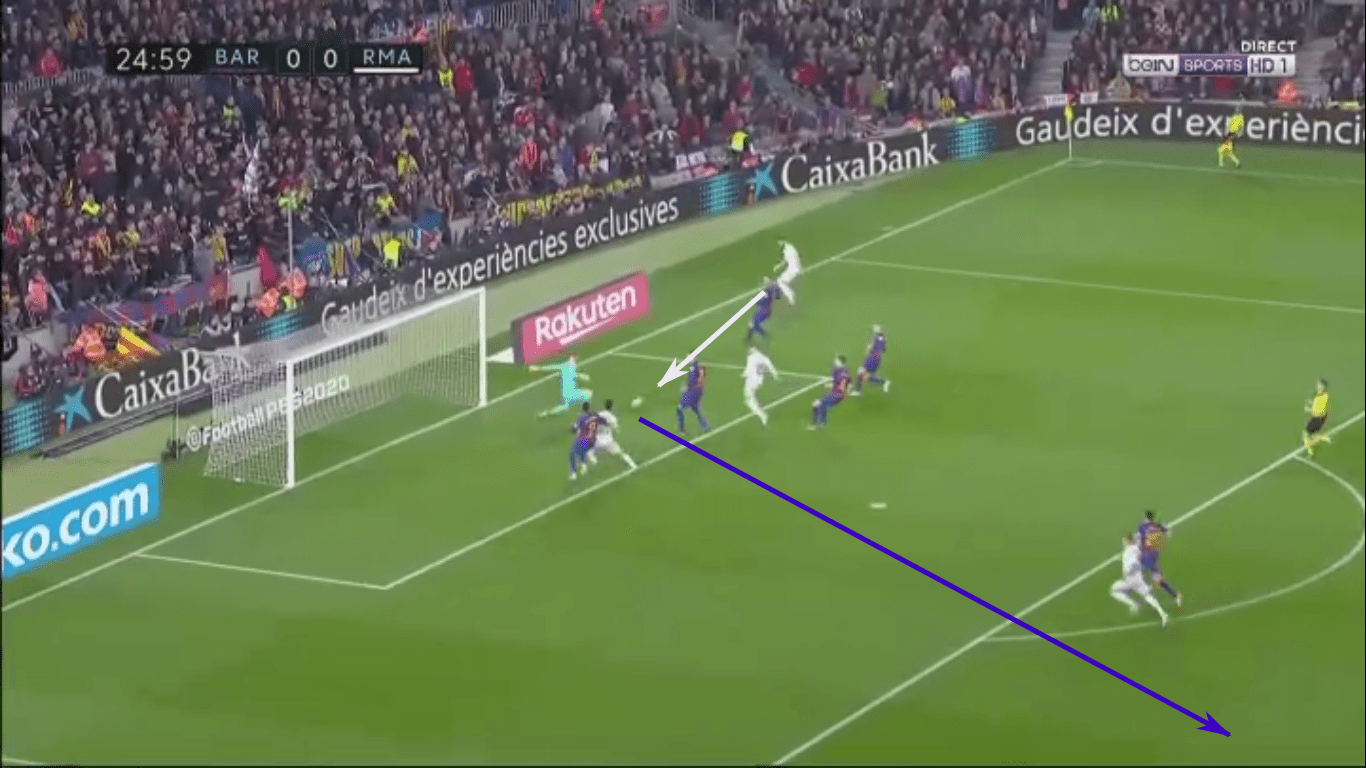
A heavy touch from Benzema took him to the endline, where he was only able to play a negative pass roughly four metres from goal. Excellent anticipation from ter Stegen allowed him to slide and kick the ball away. One or two metres further from goal or an earlier pass would have allowed Benzema to find a teammate. For Madrid, executing the final pass was the great frustration of the night. Many quality opportunities were laid to waste at their own hands.
Real Madrid attacks in waves
After a strong opening ten minutes to the game, momentum shifted against Barcelona. Madrid outshot Barcelona 17 to nine and out-crossed them 32 to eight. Granted, crosses aren’t the preferred route to goal for Barcelona and, to their credit, they did create a few very high-quality opportunities.
Still, Madrid was dangerous in possession, forcing Barca into clearances rather than interceptions and tackles. As you’ll see in a moment, Madrid was able to commit numbers high up the field when in possession, stretching the field vertically. With Barcelona’s lines so stretched, those clearances weren’t reaching the forwards, allowing Madrid to restart another wave of attack. That forced Griezmann back to defend, many times to no avail. Even when parking the bus, the absence of outlets and Madrid’s overloads in wings and half-spaces meant Barcelona were forced to defend for long spells.
In terms of average starting points, only Messi, Suárez, and Griezmann had their average first action in the Madrid half. For Real Madrid, every field player except Varane, Ramos, and Casemiro had an average starting point in Barcelona’s half of the field.

From the 14:42 mark in the first half until 19:08, Barcelona managed 17 total touches of the ball. Of those 17 touches, 11 were either clearances or blocked shots. Of those remaining six touches, they completed one pass and two turnovers. In other terms, Real Madrid recorded more combined shots, crosses, and switches of play than Barcelona had touches during this four-minute 24 second run of play. While this was Real Madrid’s most dominant spell of play, it was not an isolated incident.
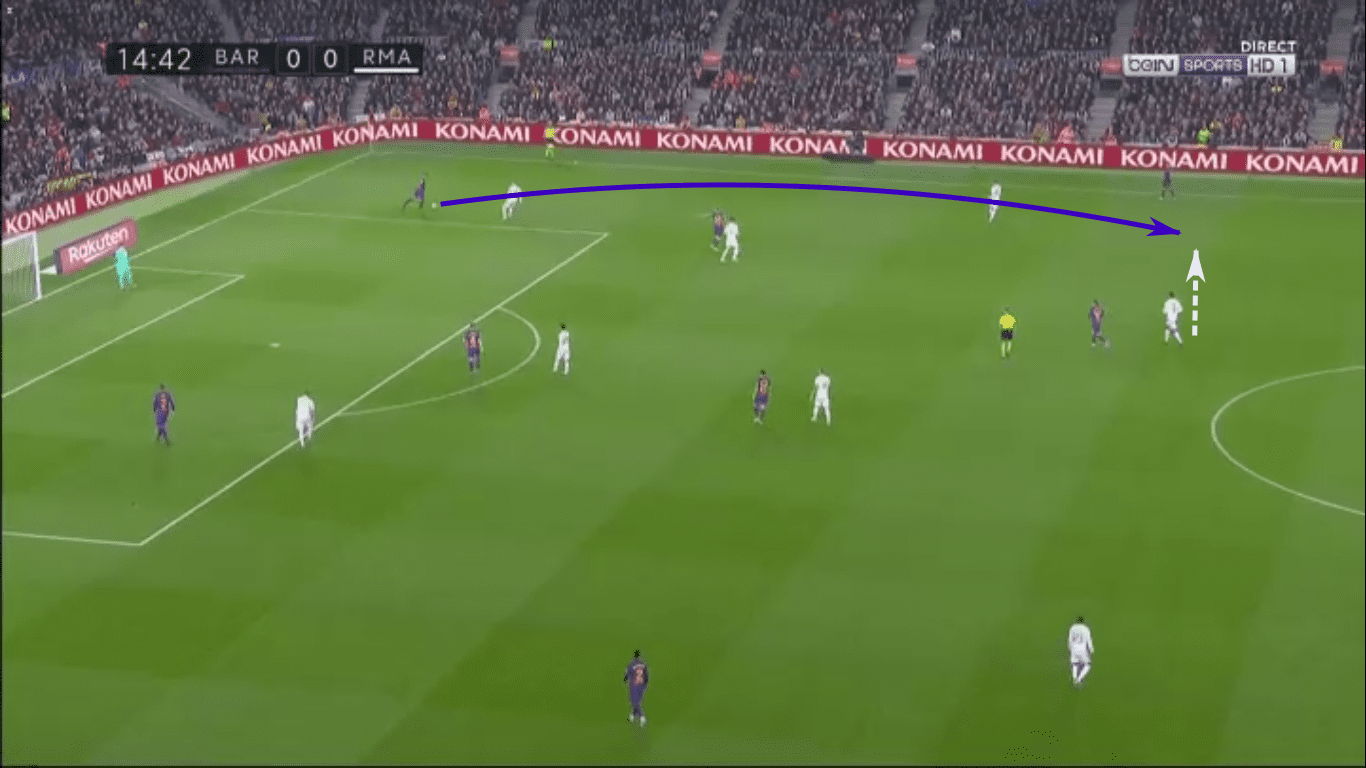
Digging into that sequence, it all started with Barcelona’s struggle to build out against Madrid’s high block with man-oriented zonal marking. Lenglet felt the pressure and took the “safe route” forward. His chip was recovered by Varane. That started the onslaught. Barcelona was forced to defend wave-after-wave of Los Blanco attacks. Anytime they managed a clearance, a Madrid midfielder or defender was there to win it as Barcelona’s three forwards stayed high up the pitch. The pressure reached such an intensity that Griezmann was called into duty, helping the midfield weather the storm. Even still, any clearance was met with a Madrid recovery as Messi and Suárez wait for play to come to them.
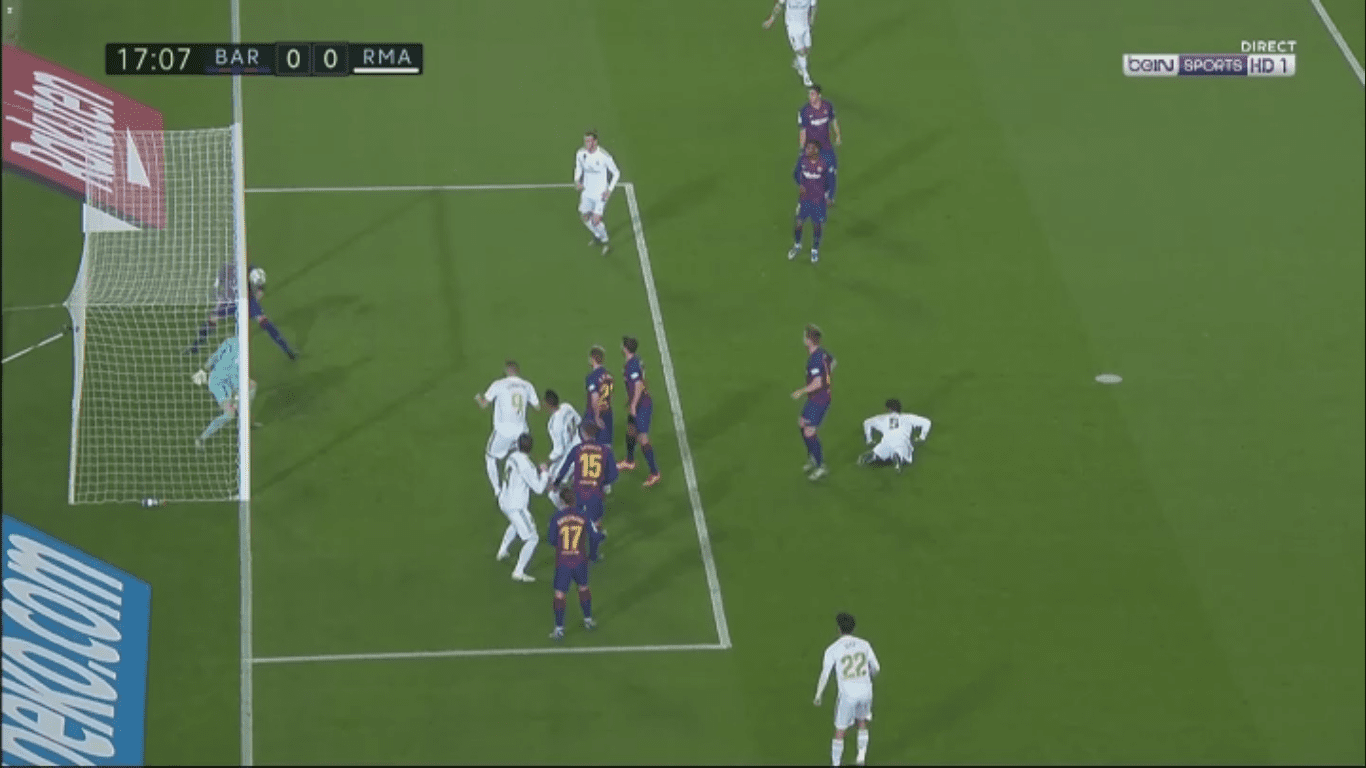
The nine behind the ball parked the bus and hoped to weather the storm. This picture represents Real Madrid’s best chance. Casemiro’s won a header off a corner kick and nearly claimed the opener. Great anticipation from Piqué prevented the goal.
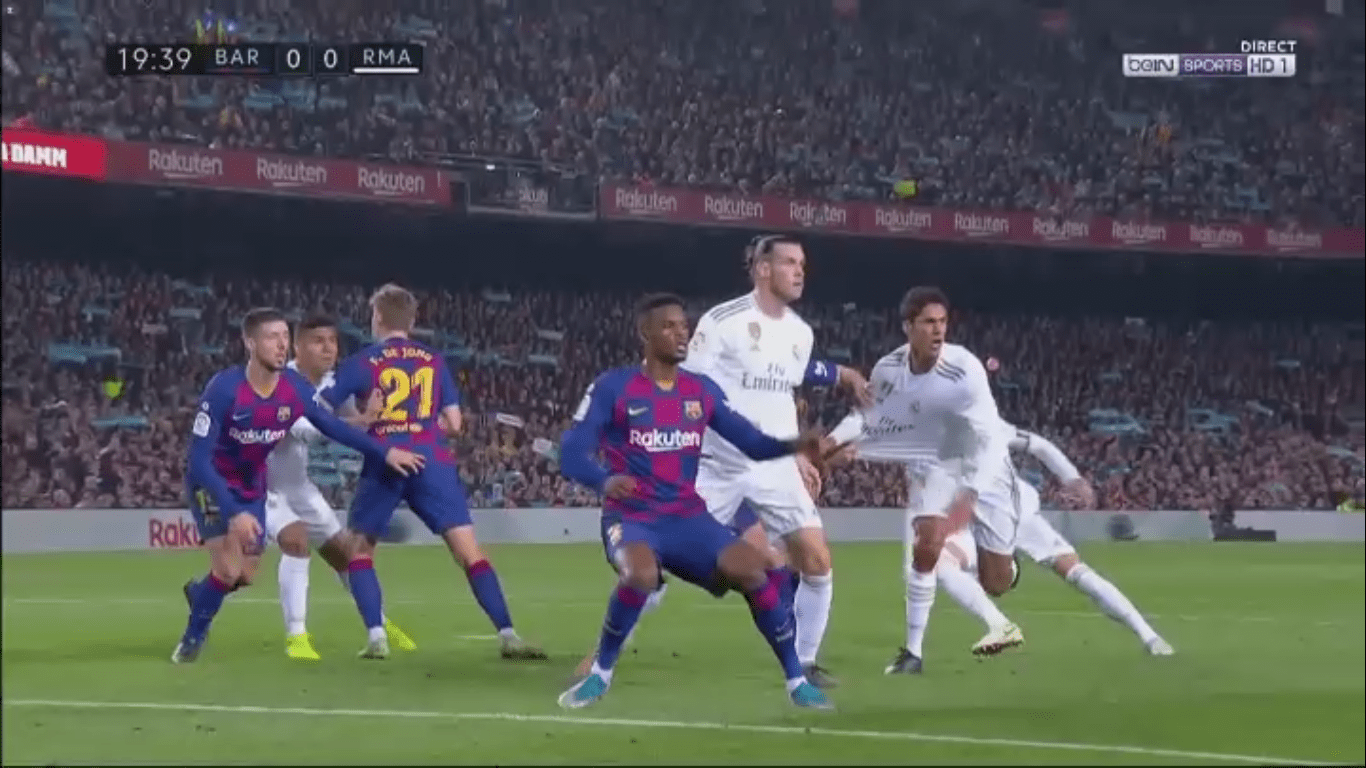
This is also the run of play that produced the greatest controversy of the night (twice actually). In this image, Rakitic clearly pulls on the shirt of Varane, preventing his play on the ball. This came moments after Alba went high while tackling Varane in the box, leaving the Frenchman will stud marks down his thigh. If you can credit referee Alejandro Hernandez with anything, it’s that he was consistent in his approach, letting the physicality of the game play out.
Wasted chances in transition
As I mentioned in the El Clásico preview, transitions had the potential to unlock the game. In a game that saw Barcelona make careless mistakes in the defensive and middle thirds, as well as Real Madrid getting caught with too many numbers forward, both teams were able to create, but not capitalize, on transitional moments.
Both teams were very good on the dribble, frequently beating the first attacker and driving at the second. Barcelona had 17 successful dribbles in 24 attempts and Madrid was 13 for 19. For Barcelona in particular, there seemed to be a dependence on individual magic to create something out of nothing, especially when the ball arrived at Messi’s feet.
That said, both teams were wasteful in transition. At times, there was a lack of understanding in the attack’s pace. Other times, the second and third attackers either didn’t make the right run or any run at all, even to simply create space for a teammate.
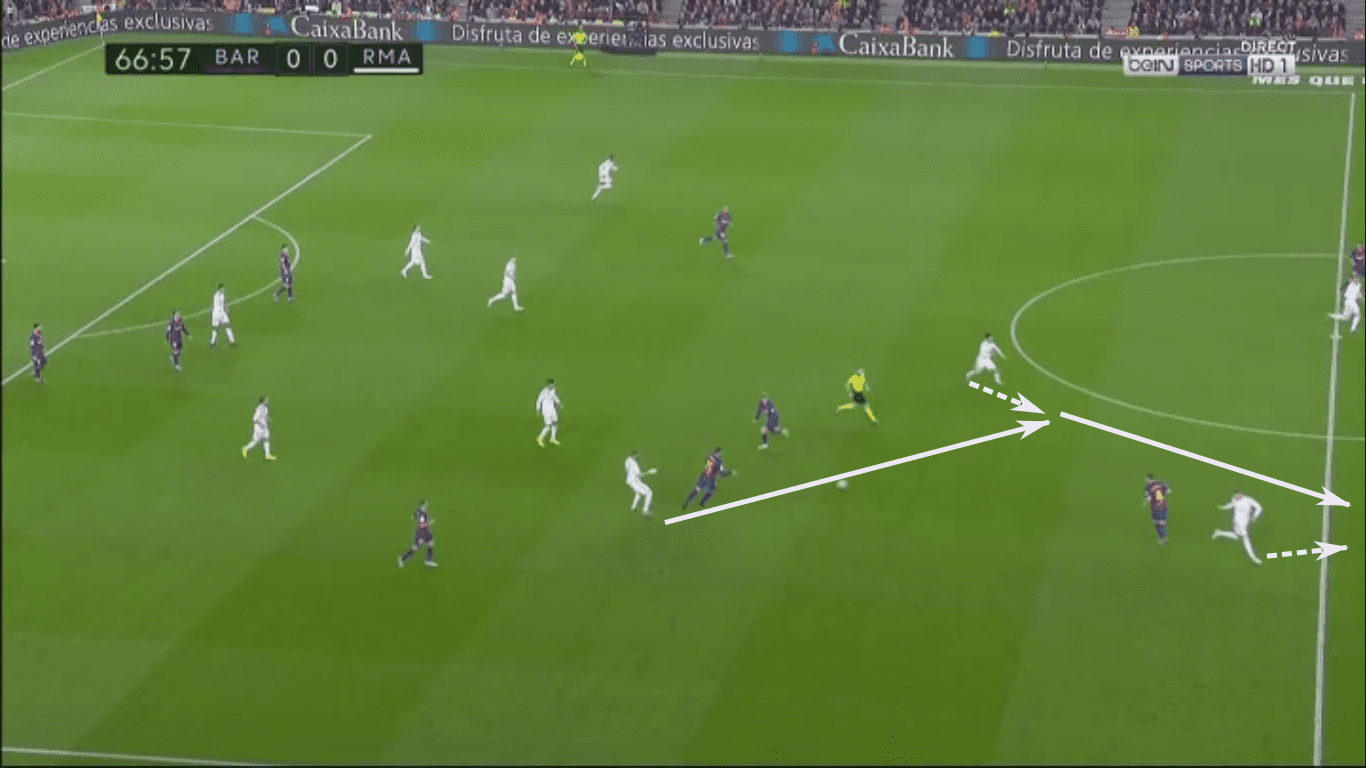
After Kroos poked a Messi flick away from Suárez, Valverde played Benzema, who spun away from pressure and released Isco into space. With Valverde continuing his run, Isco played him behind Rakitic.
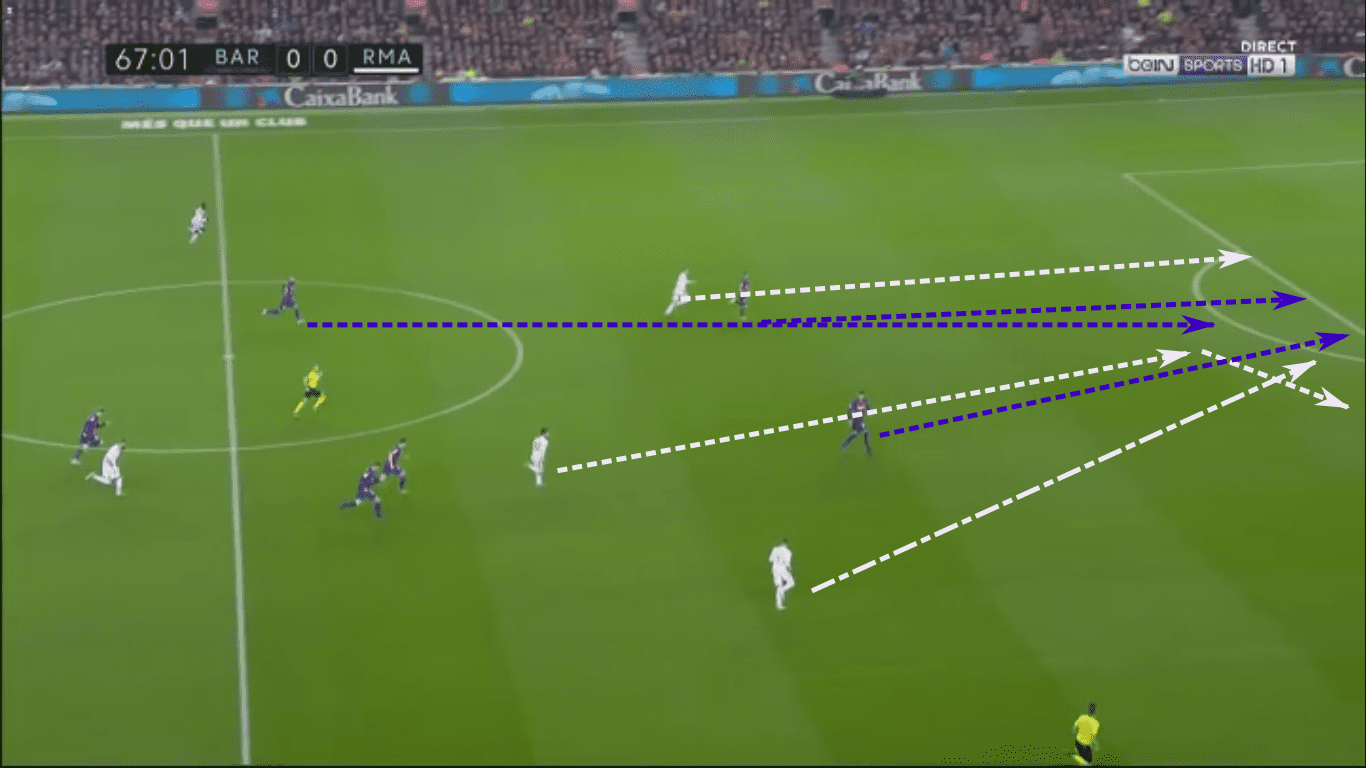
Isco’s momentum carried him beyond Rakitic, giving Real Madrid a 3v2. With three Barcelona defenders in pursuit, including the fresh-legged Vidal, Madrid needed to push play quickly, forcing Barcelona’s two remaining defenders to commit to the ball or the runner.
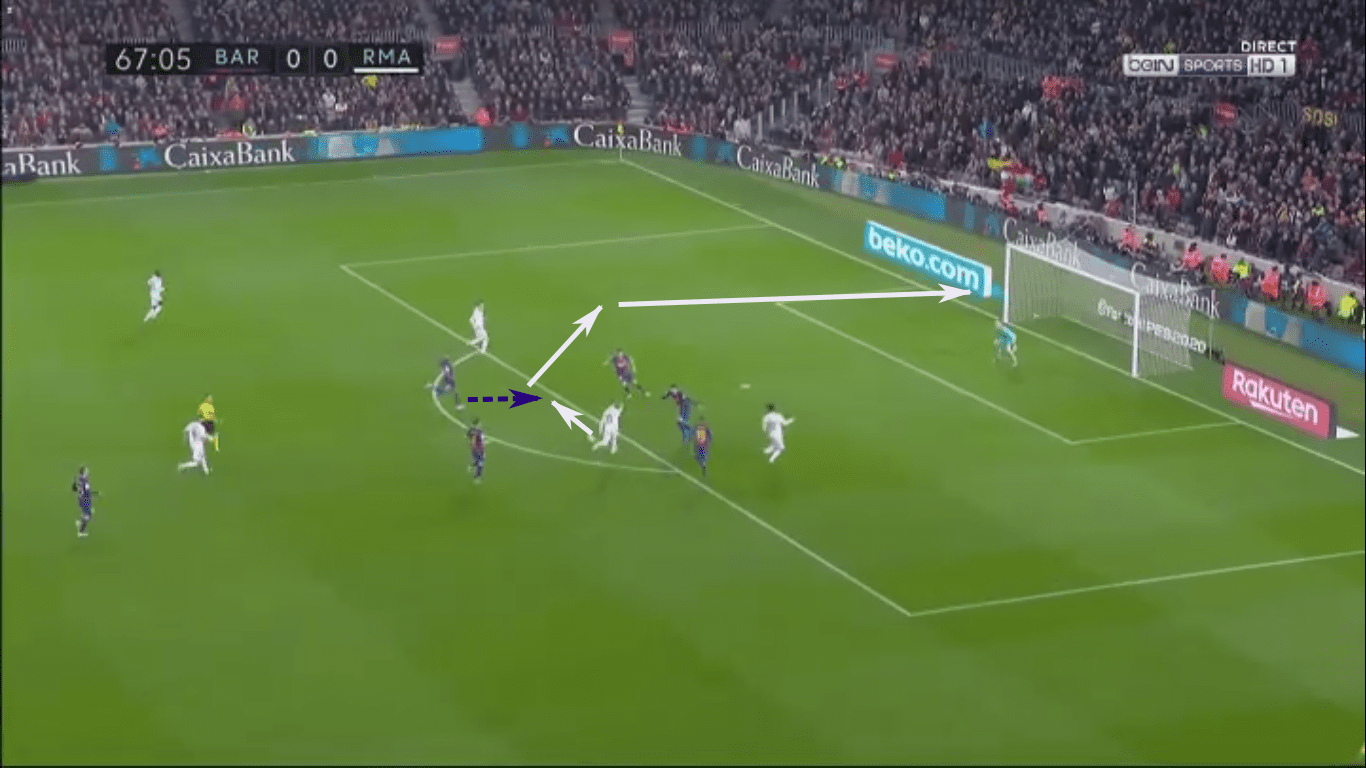
Instead, Valverde held onto the ball too long, allowing Piqué to slow him down. Piqué’s fantastic defending allowed Vidal to slide into Valverde’s initial pass to Bale. The follow-up pass sent Bale too far to his left, giving the Welshman a poor angle to goal, as he sent his shot into the side-netting.
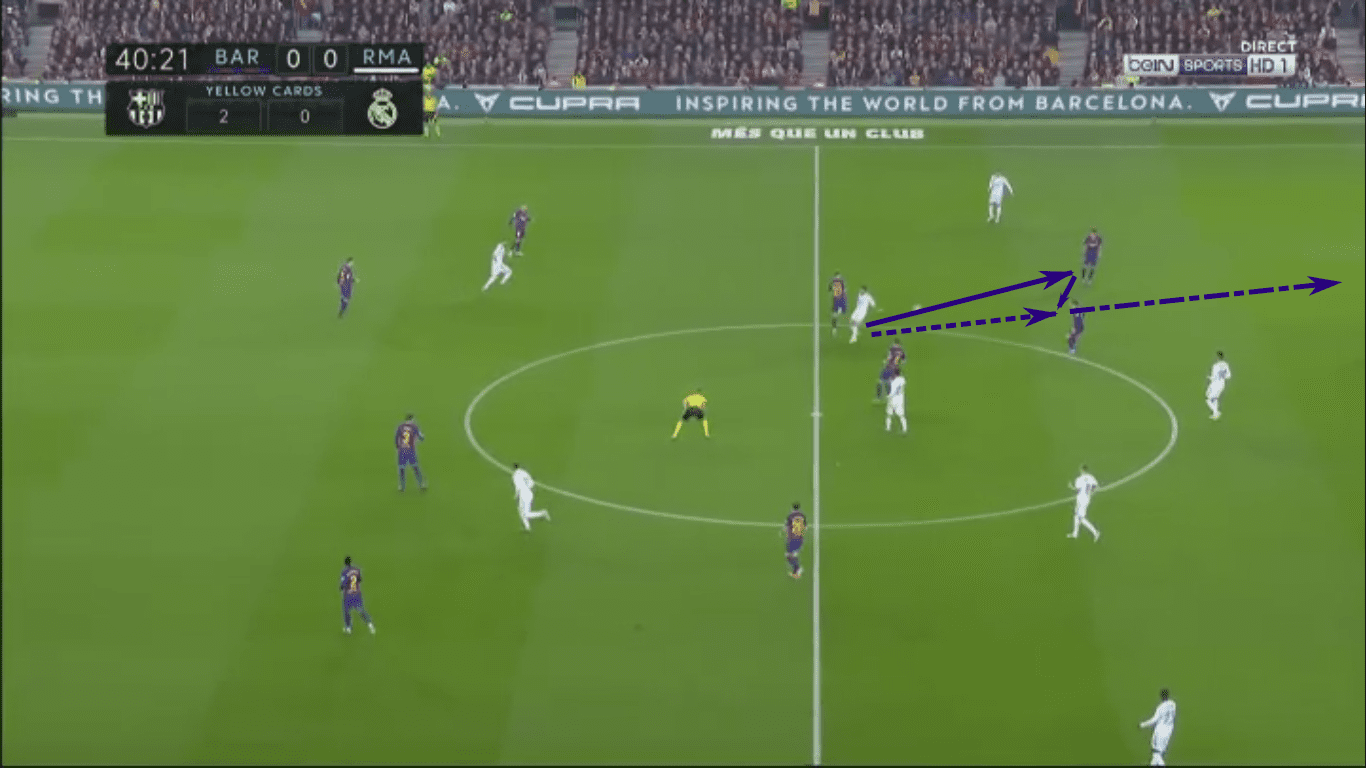
Barcelona was equally wasteful in transition. In this instance, de Jong recovered the ball combined first with Griezmann, then later with Suárez.
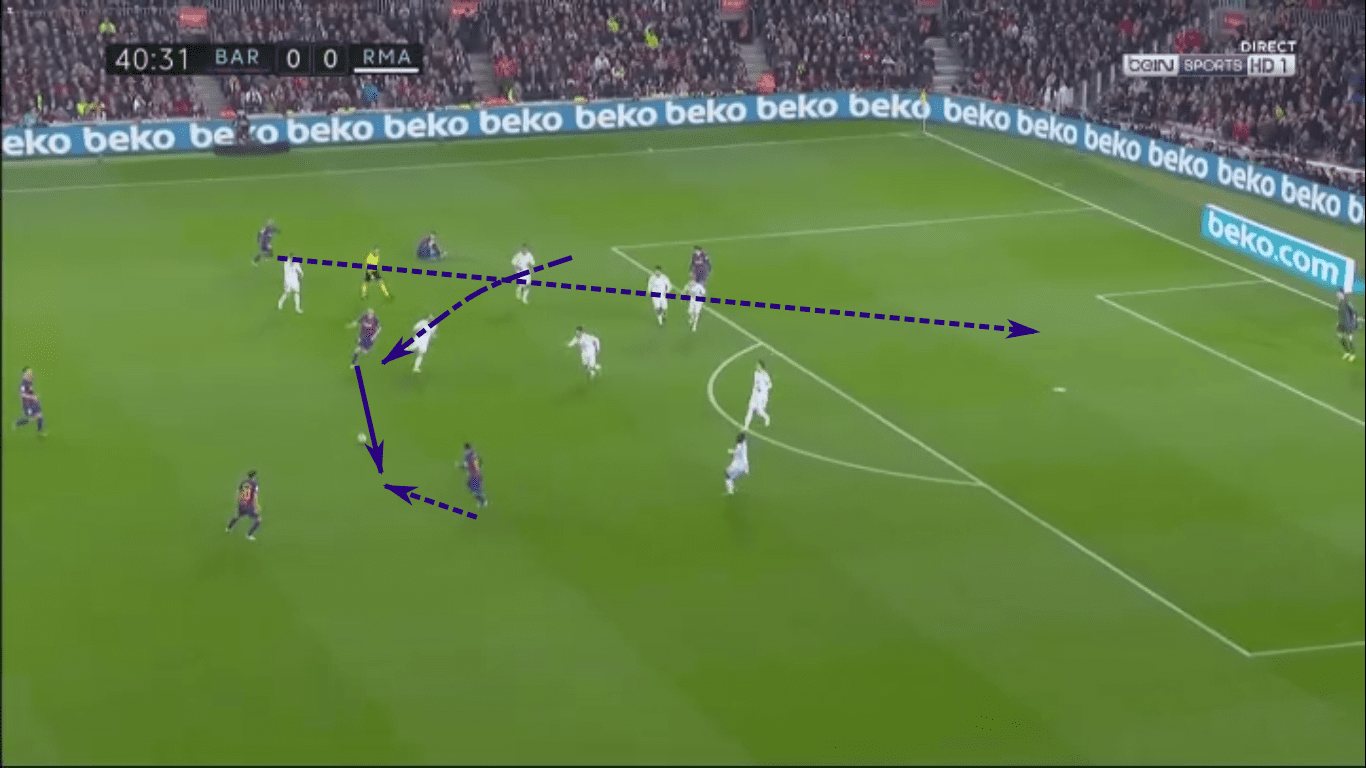
Surrounded by Madridistas, de Jong dribbled backward and centrally, then passed to Messi. You’ll notice the run of Alba near the top of the image. Just second before this screenshot, he was out of sight. His 60-metre mad dash was untouched.
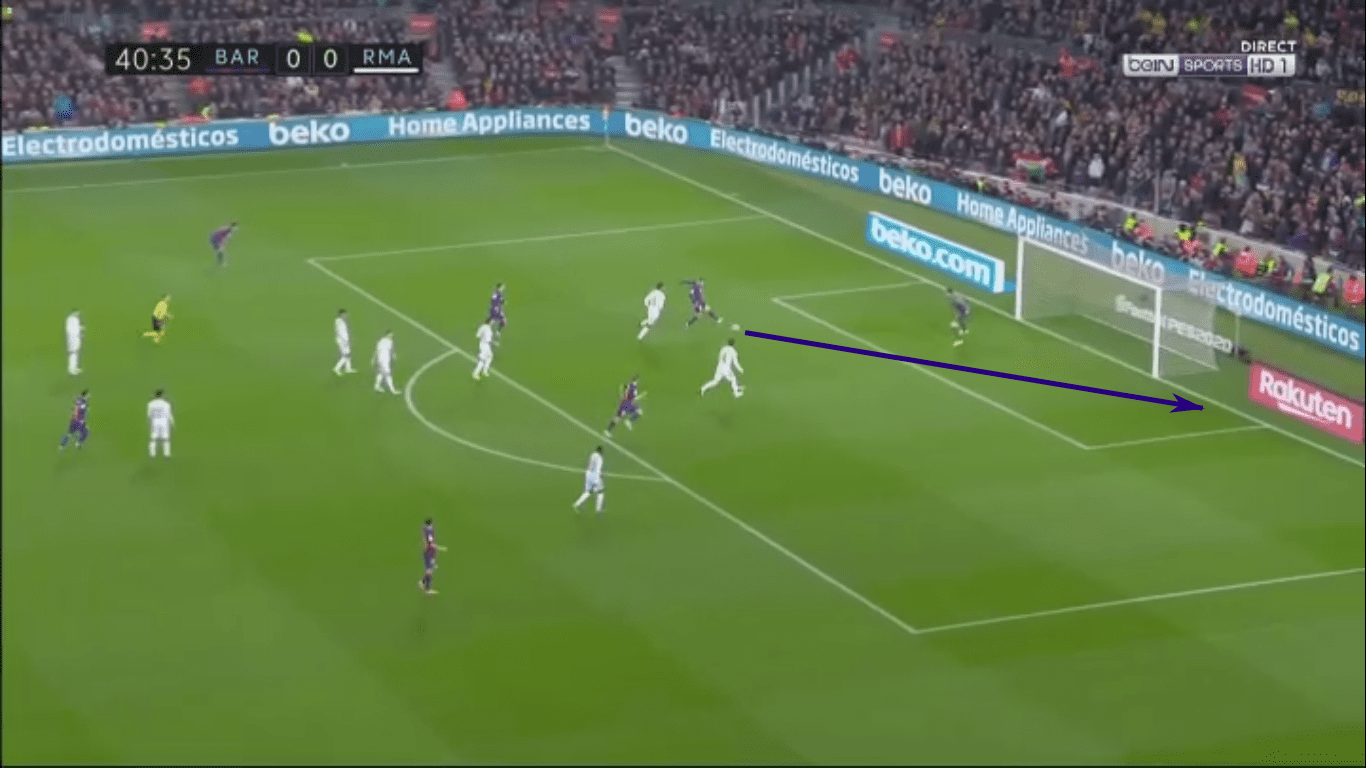
Messi delivered a sumptuous ball into the box. Alba was nine metres out with no one near enough to contest him, but he still pushed the volley wide of the target.
Conclusion
For Real Madrid, many, myself included, had a pessimistic outlook for the club. This draw and more recent performances are breathing a sense of belief into the post-Cristiano Ronaldo Madrid squad. While they’re still not finishing as clinically as they would hope, the play leading up to the final product has greatly improved, especially in their defensive approach, attacking transitions and possessions. Though the Champions League draw was not kind to them, Zidane and company will feel suitably prepared for any encounter, including Sunday’s fixture against Athletic Club.
Barcelona will surely leave this game with a sense of anxiety, much like Real Madrid felt at this time last season. As mentioned in the tactical preview of El Clásico, their goal differential masks the glaring discrepancy between Barcelona’s expected vs actual goals for and against. While you can never count out Messi or Suárezsuare, 13 goals above expected outcomes is a marvellous accomplishment that will surely see some regression. Add in the fact that Barcelona is conceding more goals than their xGA and you’ve got a problem. While they have the quality to overcome Napoli in the UEFA Champions League Round of 16, the second half of the season depends on Barcelona’s success in transition. While they’ll look for a positive performance Saturday against Deportivo Alavés, it’s safe to say that Pep Guardiola’s influence has certainly run out in Barcelona.

If you love tactical analysis, then you’ll love the digital magazines from totalfootballanalysis.com – a guaranteed 100+ pages of pure tactical analysis covering topics from the Premier League, Serie A, La Liga, Bundesliga and many, many more. Buy your copy of the December issue for just ₤4.99 here





Comments